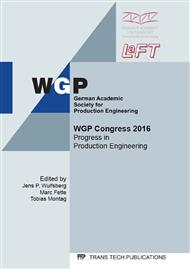[1]
M. Fried, Innovative Spanntechnik, ein Mehrwert für den Kunden, in: Intelligent produzieren, Springer-Verlag Berlin Heidelberg (2010), pp.121-127.
DOI: 10.1007/978-3-642-13101-1_11
Google Scholar
[2]
P. Hehenberger, Computerunterstützte Fertigung, Springer-Verlag Berlin Heidelberg (2011), pp.56-78.
Google Scholar
[3]
M. Weck, C. Brecher, Werkzeugmaschinen, Maschinenarten und Anwendungsbereiche, Springer-Verlag Berlin Heidelberg (2005).
DOI: 10.1007/978-3-540-28085-9
Google Scholar
[4]
C. Brecher, M. Esser, S. Witt, Interaction of manufacturing process and machine tool, CIRP Annals - Manufacturing Technology 58 (2009), 588–607.
DOI: 10.1016/j.cirp.2009.09.005
Google Scholar
[5]
B. Minhang, Y. Heng, Squeeze film air damping in MEMS, 25th Anniversary of Sensors and Actuators A: Physical, Volume 136, Issue 1 (2007), 3–27.
DOI: 10.1016/j.sna.2007.01.008
Google Scholar
[6]
B. -A. Behrens, R. Krimm, V. Salfeld, New Methods to Reduce the Vibrations of the Ram and the Press Body while Blanking of Sheet Metal, Key Engineering Materials Vol. 549 (2013), 277-283.
DOI: 10.4028/www.scientific.net/kem.549.277
Google Scholar
[7]
B. -A. Behrens, T. Pielka, Einfluss der Presseneigenschaften auf den Werkzeugverschleiß und die Schnittflächenqualität, EFB-Forschungsbericht, Hannover (2011).
Google Scholar
[8]
M. Hirsch, Einfluss von Leichtbauwerkstoffen in schnelllaufenden Stanzwerkzeugen auf das Verschleißverhalten, Dissertation, Lehrstuhl für Umformtechnik und Gießereiwesen der Technischen Universität München (2012).
Google Scholar
[9]
V. Salfeld, T. Matthias, R. Krimm, B.A. Behrens, Analysis of Machine Influence on Process Stability in Sheet Bulk Metal Forming, 45th CIRP Conference on Manufacturing Systems (2012).
DOI: 10.1016/j.procir.2012.07.007
Google Scholar
[10]
H. Hoffmann, M. Hirsch, Einfluss von Verlagerungen in Schneidwerkzeugen auf die erreichbaren Standzeiten der Werkzeugaktivelemente, EFB-Forschungsbericht Nr. 293, Hannover (2009).
Google Scholar
[11]
Q. Xia1, T. Xu1, G. Hong, W. Ruan, Prediction of the sound pressure level of blanking noise during sheet-metal blanking using servo press with counterforce, Journal of Mechanical Science and Technology 28 (5) (2014), 1673-1681.
DOI: 10.1007/s12206-014-0312-2
Google Scholar
[12]
A. Ghiotti, S. Bruschi, P. Regazzo, Shear surface control in blanking by adaptronic systems, 11th International Conference on Technology of Plasticity, ICTP 2014, 19-24 (2014).
DOI: 10.1016/j.proeng.2014.10.359
Google Scholar


